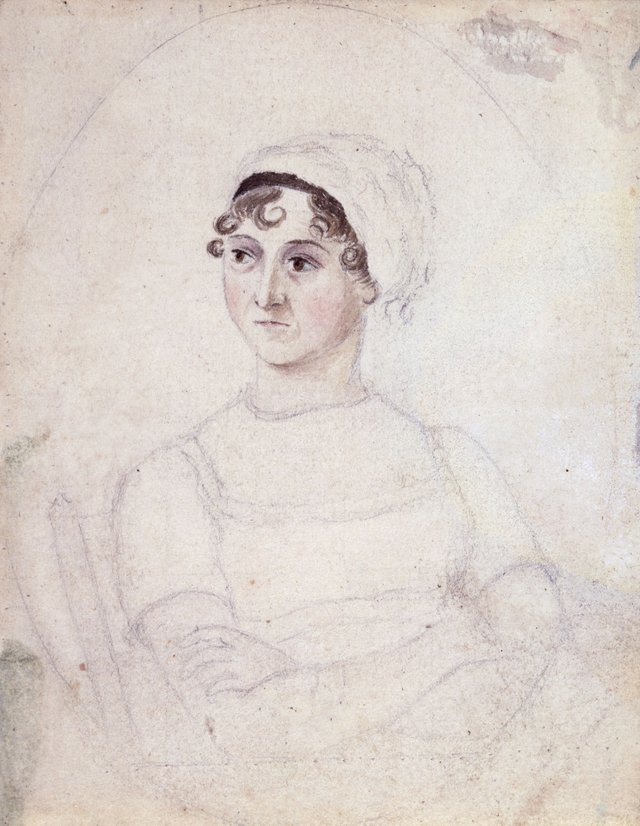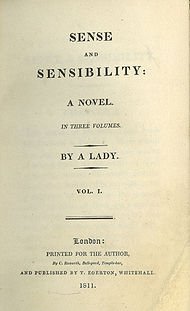
Jane Austen (16 December ,1775 – 18 July 1817) was an English novelist known primarily for her six major novels, which interpret, critique and comment upon the British landed gentry at the end of the 18th century. Austen's plots often explore the dependence of women on marriage in the pursuit of favourable social standing and economic security. Her works critique the novels of sensibility of the second half of the 18th century and are part of the transition to 19th-century literary realism. Her use of biting irony, along with her realism and social commentary, have earned her acclaim among critics and scholars.
With the publications of Sense and Sensibility, Pride and Prejudice, Mansfield Park and Emma, she achieved success as a published writer. She wrote two additional novels, Northanger Abbey and Persuasion, both published posthumously in 1818, and began another, eventually titled Sanditon, but died before its completion. She also left behind three volumes of juvenile writings in manuscript and another unfinished novel, The Watsons. Her six full-length novels have rarely been out of print, although they were published anonymously and brought her moderate success and little fame during her lifetime.
A significant transition in her posthumous reputation occurred in 1833, when her novels were republished in Richard Bentley's Standard Novels series, illustrated by Ferdinand Pickering, and sold as a set. They gradually gained wider acclaim and popular readership. In 1869, fifty-two years after her death, her nephew's publication of A Memoir of Jane Austen introduced a compelling version of her writing career and supposedly uneventful life to an eager audience.

Around early 1809 Austen's brother Edward offered his mother and sisters a more settled life – the use of a large cottage in Chawton village that was part of Edward's nearby estate, Chawton House. Jane, Cassandra and their mother moved into Chawton cottage on 7 July 1809. Life was quieter in Chawton than it had been since the family's move to Bath in 1800. The Austens did not socialise with gentry and entertained only when family visited. Her niece Anna described the family's life in Chawton as "a very quiet life, according to our ideas, but they were great readers, and besides the housekeeping our aunts occupied themselves in working with the poor and in teaching some girl or boy to read or write...

During her time at Chawton, Jane Austen published four generally well received novels. Through her brother Henry, the publisher Thomas Egerton agreed to publish Sense and Sensibility, which like all of Jane Austen's novels except Pride and Prejudice was published "on commission", that is, at the author's financial risk. When publishing on commission, publishers would advance the costs of publication, repay themselves as books were sold and then charge a 10% commission for each book sold, paying the rest to the author. If a novel did not recover its costs through sales, the author was responsible for them. The alternative to selling via commission was the selling the copyright, where an author received a one-time payment from the publisher for the manuscript, which occurred with Pride and Prejudice. Austen's experience with Susan (the manuscript that became Northanger Abbey) where she sold the copyright to the publisher Crosby & Sons for £10 pounds, who did not publish the book, forcing her to buy back the copyright in order to get her work published, left Austen leery of this method of publishing. The final alternative, of selling by subscription, where a group of people would agree to buy a book in advance, was not an option for Austen as only authors who were well known or had an influential aristocratic patron who would recommend an up-coming book to their friends, could sell by subscription. Sense and Sensibility appeared in October 1811, and was described as being written "By a Lady".As it was sold on commission, Egerton used expensive paper and set the price at 15 shillings....
Austen was feeling unwell by early 1816, but ignored the warning signs. By the middle of that year, her decline was unmistakable, and she began a slow, irregular deterioration. The majority of biographers rely on Dr. Vincent Cope's 1964 retrospective diagnosis and list her cause of death as Addison's disease, although her final illness has also been described as resulting from Hodgkin's lymphoma. When her uncle died and left his entire fortune to his wife, effectively disinheriting his relatives, she suffered a relapse, writing, "I am ashamed to say that the shock of my Uncle's Will brought on a relapse ... but a weak Body must excuse weak Nerves".
She continued to work in spite of her illness. Dissatisfied with the ending of The Elliots, she rewrote the final two chapters, which she finished on 6 August 1816.[m] In January 1817 Austen began The Brothers (titled Sanditon when published in 1925), and completed twelve chapters before stopping work in mid-March 1817, probably due to illness. Todd describes Sanditon's heroine, Diana Parker, as an "energetic invalid". In the novel, Austen mocked hypochondriacs and though she describes the heroine as "bilious", five days after abandoning the novel she wrote of herself that she was turning "every wrong colour" and living "chiefly on the sofa". She put down her pen on 18 March 1817..
that's the end of her life, but she did not forget from ourselves..she must be remembered by her valuable novel that see,s like as "golden crop"
Hi! I am a robot. I just upvoted you! I found similar content that readers might be interested in:
https://en.wikipedia.org/wiki/Jane_Austen
Downvoting a post can decrease pending rewards and make it less visible. Common reasons:
Submit